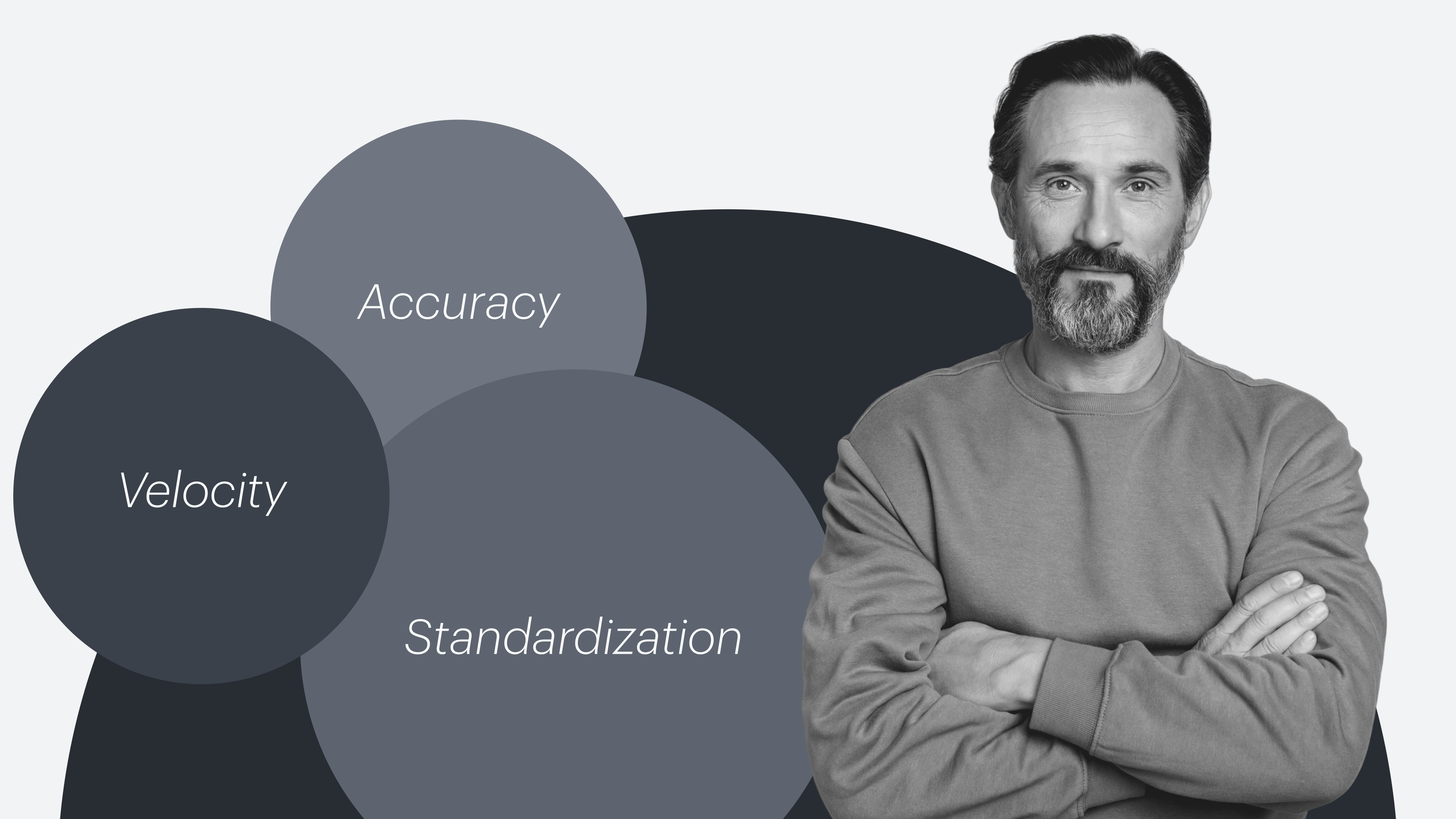
How Lucid helps engineers maintain accuracy, velocity, and standardization
Reading time: about 6 min
Key takeaways
-
Accuracy, velocity, and standardization are the foundation for successful engineering teams. While difficult to master, these principles are vital. They balance the need for speed with quality and consistency.
-
Without accuracy, projects are at risk for delays and costly rework. Lucid helps maintain accuracy by providing a centralized hub that houses all project information and important documentation.
-
Velocity is more than working quickly. It is a measure of a team’s efficiency over time. Lucid boosts team velocity by reducing friction, eliminating knowledge silos, and providing a collaborative platform that allows teams to get on the same page faster.
-
Standardization makes work repeatable and scalable. Lucid enables this by providing a repository of reusable templates and documents. This ensures consistency as teams evolve, saving time and leading to more predictable outcomes.
The entire workflow of an engineer is a balancing act between accuracy, velocity, and standardization. It’s not just about quickly shipping a product; it’s about being intentional about how a team collaborates, operates, and iterates so that a job well done can be a job that’s consistently repeated. We all want to launch products and features swiftly, but not at the cost of quality. There is something to be said about balancing team velocity with accurate information and standardized workflows.
We sat down with Ryan Running, senior product marketing manager at Lucid, to get his take on these challenges. His perspective is that though these three pillars can be tough to master, they are vital for building a high-performing engineering team. In this article, we explore his insights on why these principles are challenging and how engineers can use Lucid to maintain accuracy, boost velocity, and streamline standardization.
Accuracy
Why it's important
Accuracy is the foundation on which everything else is built. Without accuracy, every decision you make is a calculated risk. If information is inaccurate in the beginning stages of the project, whether that be a flawed diagram or outdated documentation, the entire project is thrown off, causing delays, costly rework, and demoralized teams.
If processes, visualizations, and documentation are inaccurate, everything else will inevitably crumble.
Why it's hard to achieve
Creating and maintaining a single source of truth is difficult with so many moving parts. According to Lucid’s work acceleration survey of over 2,100 knowledge workers worldwide, 44% of respondents expressed that misalignment was a major blocker in their workflow.
Important information often lives on different apps, text documents, and locked spreadsheets, creating a fragmented workflow. This makes it impossible to ensure people are looking at the same information and that it stays up-to-date.
How Lucid enables accuracy
With Lucid, teams can easily create a central place for documenting systems and processes, ensuring all team members are working with current and accurate data. Plus, with the added layer of visual collaboration, teams can work together confidently, knowing they have the most updated information for projects and tasks.
Team hubs provide a centralized location to house all team work, eliminating information silos. Instead of searching through spreadsheets, documents, emails, and chat threads, your team’s resources can live in one, organized place.

Learn how to set up your team hub.
Read nowEmbedded links transform a static document into a living canvas. Within your Lucid document, you can link out to Google Workspace, Microsoft OneDrive, Confluence, and more. What’s more, any changes you make to your external documents will automatically be reflected in Lucid. This way, your team can pull multiple sources into one workspace from one document, knowing they have the most accurate information.
“Self-inflicted setbacks are the most painful. Having accurate, up-to-date process documentation helps teams avoid these frustrating setbacks and limit risk during projects. With dozens of integrations, data-backed diagrams, approval processes, and centralized repositories, Lucid has everything your teams need to keep that documentation accurate and accessible.”— Ryan Running, senior product marketing manager, Lucid
Velocity
Why it's important
More than just quickly building and launching a feature, velocity is measured by the work a team accomplishes within a time period, like a sprint. It is a performance metric often used in Agile and Scrum methodologies and helps teams better understand how they collaborate. Velocity is about performance longevity and continuous improvement.
Why it is hard to achieve
Even the most well-planned projects can be bogged down by common project disruptions. Last-minute design changes, feedback from stakeholders, and poorly communicated dependencies can slow momentum.
But that’s not all—disconnected knowledge silos exemplify the struggle. If a team member is on PTO or leaves the company, their expertise often leaves with them. The team is left scrambling to find diagrams, sheets, and documents containing critical project information, causing yet another deadline pushback.
How Lucid enables velocity
Fortunately, teams that use Lucid can eliminate the friction that slows them down. By providing a truly collaborative platform, Lucid empowers teams to build a shared understanding as they work. When complexities are visualized, teams get on the same page more quickly, reducing the need for meetings and allowing engineers to focus on building.
Visual Activities help leaders quickly see where a team is at for various topics, speeding up the prioritization process, getting quick feedback, gauging bandwidth, and more.


The Lucid Cards for Jira integration turns your Jira backlog into a dynamic, collaborative workspace. With bidirectional sync, teams can visualize project dependencies and brainstorm ideas, and then convert them into Jira issues without ever leaving the canvas. This makes project planning more engaging, helping align your team and stakeholders and keeping the momentum going.
airfocus is now a part of Lucid, and together, Lucid and airfocus fuse flexibility with structure, allowing product managers to move past the rigidity of product roadmaps and into a dynamic workflow. Teams can now brainstorm and plan ideas in Lucid and then seamlessly send them back to airfocus to create strong, data-backed roadmaps. Connect collaborative ideation directly to your plan of action, ensuring every feature you build is impactful.
An example of a roadmap in airfocus
“IT and engineering teams are constantly asked to get more done with fewer resources. Lucid provides collaboration and visualization features like our Jira integration with dynamic tables and timelines that help teams align quickly on the highest impact work to be done.” — Ryan Running, senior product marketing manager, Lucid
Standardization
Why it's important
Standardization bridges the gap between individual efforts and a scalable system. It’s the process of agreeing on a single way to do things so that every team member can work consistently. Without it, misalignment takes over, causing a slew of issues. Deadlines get missed, team morale diminishes, and goals fail to be reached.
In fact, the work acceleration survey reported that one in five respondents felt that having access to standardized, updated process documentation would save them three or more hours a day, nearly half the workweek.
Why it is hard to achieve
Standardizing processes and procedures can be extremely difficult. Without proper tools, it can be a laborious, overwhelming task, and it may feel like a waste of time. But with the right platform, it can transform workflows and unify teams and stakeholders.
How Lucid enables standardization
Lucid helps teams create a repository of repeatable work, which ensures effective standardization as your teams evolve. The system isn’t rigid; it’s a flexible framework that adapts to your needs while remaining consistent.
Lucid templates let you quickly create documentation, diagrams, and other dynamic visualizations. To take it a step further, you can create themes to style your documents to align with your brand and style.
Lucid’s Process Accelerator helps engineering teams standardize how work gets done by creating a single, searchable source of truth. Organizations can efficiently manage knowledge repositories and the content within them. Any updates to that content must go through an approval flow before they are published. They also have access to an asset library to accelerate process documentation and increase standardization. Not only does this keep people on the same page, but it speeds up stakeholder approval.

“Companies with standardized practices and workflows reduce their risk and increase efficiency. With Lucid’s blueprints, templates, and process management capabilities, teams can implement standard workflows and keep them up-to–date, spending less time figuring out how to accomplish the work and instead moving forward with confidence and alignment.” — Ryan Running, senior product marketing manager, Lucid
Through Lucid, teams can not only achieve accuracy, velocity, and standardization but also sustain this level of high-quality work.

Gain more insights on how to accelerate your engineering teams’ work with Lucid.
Read moreAbout Lucid
Lucid Software is the leader in visual collaboration and work acceleration, helping teams see and build the future by turning ideas into reality. Its products include the Lucid Visual Collaboration Suite (Lucidchart and Lucidspark) and airfocus. The Lucid Visual Collaboration Suite, combined with powerful accelerators for business agility, cloud, and process transformation, empowers organizations to streamline work, foster alignment, and drive business transformation at scale. airfocus, an AI-powered product management and roadmapping platform, extends these capabilities by helping teams prioritize work, define product strategy, and align execution with business goals. The most used work acceleration platform by the Fortune 500, Lucid's solutions are trusted by more than 100 million users across enterprises worldwide, including Google, GE, and NBC Universal. Lucid partners with leaders such as Google, Atlassian, and Microsoft, and has received numerous awards for its products, growth, and workplace culture.
Related articles
5 ways engineering teams can streamline project documentation with Lucid
Get insider tips on using Lucid for project documentation from Lucid’s senior director of engineering.
How to build high-performing engineering teams
In this post, we’ll define what a high-performing engineering team is and provide six actionable tips for building one.
The engineer’s toolkit for effortless documentation
To get you started with collaborating visually and documenting as you go, we’ve compiled a toolkit of templates for common engineering use cases.
The acceleration equation: What’s slowing teams down (and how to fix it)
Learn how tool overload, fragmented processes, and lack of access to information are impacting teams today.
